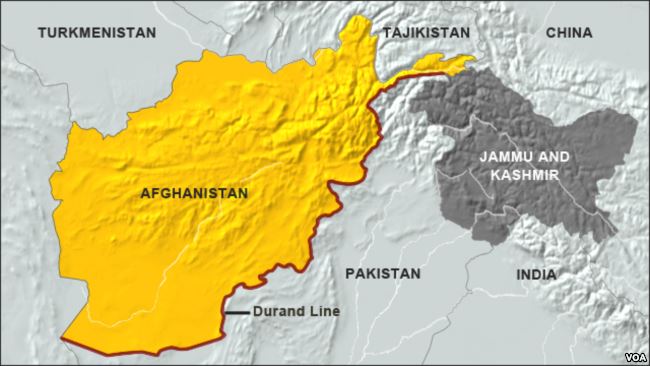
Radio Free Europe/Radio Liberty
February 5, 2021
Frud Bezhan
Daud Khattak
Families, traders, and guerrilla fighters have for generations moved freely across the porous border between Afghanistan and Pakistan.
The disputed 2,670-kilometer frontier traverses some of the world’s most forbidding terrain, snaking through desolate deserts and towering mountains more than 4,000 meters high.
Drawn by British colonial officials in the 19th century, the arbitrary border also splits the estimated 50 million ethnic Pashtuns living on either side of the so-called Durand Line.
“Every day, people from my village went to the Afghan side for work, to drive taxis, or to sell goods,” says Abdul Yousaf, a trader from Pakistan’s Kurram district, which borders Afghanistan’s southeastern Khost Province.
But that began to change in 2017, when the Pakistan military started to erect a pair of 3-meter-high metal fences topped with razor wire along the entire border. It closed scores of informal crossings and limited cross-border travel to 16 official posts.
Despite the formidable logistical challenges, Pakistani officials announced in January that some 90 percent of the fence was complete. It is scheduled to be finished by June.
The Pakistani Army has credited the new barrier with reducing cross-border militant attacks in the South Asian nation of some 220 million people.
But Pashtun communities straddling the border say it has divided families and sunk businesses.
Islamabad’s unilateral move has also triggered condemnation in Afghanistan, which disputes the border and claims some swaths of Pakistani territory.
‘Improved Pakistan’s Security’
The Pakistani military began constructing the fence following a series of deadly army operations in the country’s tribal areas starting in 2014.
The largely lawless tribal areas had been a stronghold for extremist groups after the U.S.-led invasion of Afghanistan in 2001, including Al-Qaeda, the Afghan Taliban, the Haqqani network, and Tehrik-e Taliban Pakistan (TTP), also known as the Pakistani Taliban.
The army offensives forced TTP militants, who had waged a deadly insurgency against the Pakistani armed forces and state since 2007, to flee to Afghanistan. The other extremist outfits, with alleged support from the Pakistani Army, remained or resettled in other areas of Pakistan.
The operations, which also displaced millions of civilians and killed thousands, were credited with curbing the soaring number of militant attacks in Pakistan.
Pakistan witnessed 319 terrorism-related incidents and 169 associated deaths of civilians in 2020, according to the South Asia Terrorism Portal, a New Delhi-based database tracking extremist movements in the region.
It marks a dramatic decrease compared to 2013, when there were nearly 4,000 terrorist-related incidents and over 2,700 deaths.
Pakistan’s construction of the fence is seen as an attempt to safeguard those gains.
“From a military perspective, the fence has definitely improved Pakistan’s security,” says Ayesha Siddiqa, a Pakistani author and expert on the country’s military. “It has allowed the Pakistani Army to secure itself against nonstate actors that are not under its control.”
“You can be flexible with a fence,” Siddiqa says. “You can allow your friends to cross over but not allow others who are your enemies.”
While Pakistan has clamped down on homegrown militants waging war in Pakistan, Islamabad is thought to have backed other Pakistan-based Afghan and Kashmiri militants as proxy forces in Afghanistan and India.
The powerful Pakistani military, which has an oversized role in the country’s domestic and foreign policies, has long been accused of supporting the Afghan Taliban to reach its longstanding strategic goals in Afghanistan: installing a pro-Pakistani government in Kabul and limiting the influence of its archrival India, which has close ties to Kabul.
Pakistan’s ties to the Taliban date back to the 1990s, when it provided arms, training, and intelligence to the militants. Islamabad was one of only three countries to recognize the Taliban regime that took power in Afghanistan in 1996. After its fall in 2001, many Taliban leaders took shelter inside Pakistan.
Reemergence Of The Pakistani Taliban
But many observers are skeptical that the fence alone will stop militants, considering the border spans such inhospitable terrain. Others also say local corruption and bribery of guards at the crossings are problematic.
Highlighting the obstacles, TTP militants have reemerged in their previous strongholds in the tribal areas and have staged dozens of deadly attacks in recent months.
In one of the deadliest attacks, 11 Pakistani soldiers were killed in two blasts in South Waziristan on October 15. Six were killed after their vehicles struck roadside bombs. As another military vehicle rushed to the scene, a second explosion killed five more soldiers.
The TTP claimed responsibility for both explosions.
Militants have also attacked construction teams along the border and posted videos online showing them destroying sections of the fence and capturing construction supplies.
‘No Afghan Government Will Accept It’
Siddiqa says there is also a “political dimension” to the Pakistani Army’s fortification of the border.
“The fence is basically a de facto statement on the Durand Line,” she says.
British India and Afghan King Abdur Rahman Khan agreed to the current border in 1893. Pakistan, which shed its status as part of British India more than 70 years ago, considers the line to be an international border, as does most of the international community.
But Afghanistan has never recognized the border and refers to it as the Durand Line.
Kabul has condemned Pakistan’s decision to fortify the border, insisting that activities by either side along the Durand Line must be approved by both countries.
Pakistan’s new border defenses have also triggered numerous deadly clashes along the frontier in recent years.
In July, at least 15 Afghan civilians were killed after clashes erupted between Afghans and Pakistanis at the Chaman border crossing. It was one of the deadliest incidents in recent years.
The clashes came after locals protested Islamabad’s plan to introduce passport and biometric systems for cross-border travel.
Firefights have also broken out as Pakistan forces have attempted to erect military installations at the border.
Janan Mosazai, Afghanistan’s former ambassador to Pakistan, says the fence will “adversely affect the bilateral relationship” and cause further “popular alienation” among Pashtuns on both sides of the border.
“Putting barriers that cut through communities straddling the Durand Line and aiming to divide a people that have the deepest social, political, and economic ties will not work, and no Afghan government will accept it,” he says.
Afghan officials say the fence will not address militancy and terrorism in the region. They say the root cause is Pakistan’s own policy of arming and sheltering militant groups that export terrorism in the region.
‘Suffered A Great Deal’
Those most impacted by the fence are Pashtun communities spanning the border who have lost the ability to cross freely to do business, visit family, or even attend school.
The fence has also brought tougher immigration regulations.
Travelers now need passports and visas to cross the border. Traders also need to pay customs fees, something that has angered many.
“Our businesses have suffered a great deal,” says Haji Nazar Din, of Pakistan’s North Waziristan district, complaining of high customs duties and long lines. “Crossing the border often takes days and weeks.”
Din says he has been a trader since 1983, exporting wheat, flour, and sugar from Pakistan to the Afghan city of Ghazni and the capital, Kabul.
“It was easy in the past, but now these border arrangements halted everything,” he says.
The new border defenses are not just bad for business. Many have families and relatives on the other side of the border.
“The fence has divided our families,” says Zohaib Wazir, a 33-year-old from Pakistan’s South Waziristan district. “We cannot visit them for months. If there is a funeral or a marriage ceremony, we cannot join them.”

